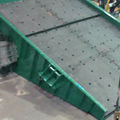WHAT ARE VIBRATING FEEDERS WITH UNBALANCED MOTORS?
March 10, 2017
There are rare instances in industry where balance is not a desirable work attribute. Of those rare occasions, picture a vibrating feeder. If it were mechanically stable, its operational demeanor would be relatively ineffectual. Just for once, system discord is the goal. Unbalanced motors imbue vibrating feeders with this required amount of mechanical turmoil, a quality of eccentric, dynamic motion that we’ll now endeavour to explain.
UNDERSTANDING UNBALANCED MOTORS
In contemplation of a seemingly counterintuitive design, an eccentric movement profile is preferred on this occasion. This is accomplished by coupling a normally vibration-less motor shaft to a non-symmetrical load. It’s that shaft-tied mass that transforms a force-regulated motor rotor into an asymmetrical brute. Certainly, the prime mover is equipped with the same rigorously tested bearings as a regular motor, plus its central shaft exhibits consistent radial momentum, but these attached weights “unbalance” the machine drive’s output.
DEMONSTRATES CENTRIFUGAL ECCENTRICITY
Intense waves of vibrational energy are generated as the unbalanced feeder motors spin their coupled weights. These are centrifugal and centripetal forces. They produce a displacement effect that functions like a frame shaker. Like a muscled hulk of a man, perhaps shaking the machine bed back and forth, the generated energy compels the mined material to move in a predictable manner. One more force is called upon to complete this displacement action. We’re referring, of course, to gravity.
EMPOWERING VIBRATING FEEDERS
The mass of the conveyed material is already bound to the work platform by the weight of gravity, but the eccentric bumps and jolts instil that static load with dynamic power. Now, the current end product may look chaotic, but there’s an engineered order behind the mechanical free-for-all. The shape of the mounted motor weight is designed to create that level of vibration. Similarly, the RPM of the shaft and its unbalanced flyweight are carefully controlled so that the generated feed profile separates material, conveys it, and provides an initial sorting action.
Vibrating feeders with unbalanced motors are commonly employed in the mining industry. Due to the nature of that industry, its intimate ties with gravity, a linear feed configuration is generally preferred. Other industries, however, alter this engineering design. There are vibratory bowl feeders, for instance, machines that sort and convey grain feed, pharmaceutical materials, and other powdery media. Meanwhile, back at the unbalanced motor, the radially driven harmonic event changes, but this excitation effect relies firmly on the physical characteristics of the weighted mass.
Optimized by: Netwizard SEO
